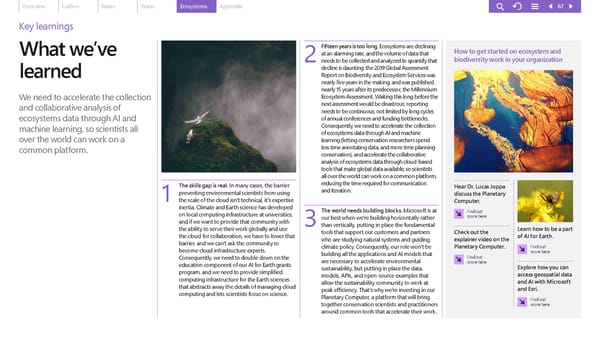Overview Carbon Water Waste Ecosystems Appendix 67 Key learnings Fifteen years is too long. Ecosystems are declining How to get started on ecosystem and What we’ve 2at an alarming rate, and the volume of data that biodiversity work in your organization needs to be collected and analyzed to quantify that decline is daunting: the 2019 Global Assessment learned Report on Biodiversity and Ecosystem Services was nearly five years in the making, and was published nearly 15 years after its predecessor, the Millennium We need to accelerate the collection Ecosystem Assessment. Waiting this long before the and collaborative analysis of next assessment would be disastrous; reporting needs to be continuous, not limited by long cycles ecosystems data through AI and of annual conferences and funding bottlenecks. machine learning, so scientists all Consequently, we need to accelerate the collection of ecosystems data through AI and machine over the world can work on a learning (letting conservation researchers spend common platform. less time annotating data, and more time planning conservation), and accelerate the collaborative analysis of ecosystems data through cloud-based tools that make global data available, so scientists all over the world can work on a common platform, The skills gap is real. In many cases, the barrier reducing the time required for communication Hear Dr. Lucas Joppa preventing environmental scientists from using and iteration. discuss the Planetary 1 the scale of the cloud isn’t technical, it’s expertise Computer. inertia. Climate and Earth science has developed The world needs building blocks. Microsoft is at Find out on local computing infrastructure at universities, our best when we’re building horizontally rather more here and if we want to provide that community with 3than vertically, putting in place the fundamental the ability to serve their work globally and use tools that support our customers and partners Check out the Learn how to be a part the cloud for collaboration, we have to lower that who are studying natural systems and guiding explainer video on the of AI for Earth. barrier, and we can’t ask the community to climate policy. Consequently, our role won’t be Planetary Computer. Find out become cloud infrastructure experts. building all the applications and AI models that more here Consequently, we need to double down on the are necessary to accelerate environmental Find out education component of our AI for Earth grants more here program, and we need to provide simplified sustainability, but putting in place the data, Explore how you can computing infrastructure for the Earth sciences models, APIs, and open-source examples that access geospatial data that abstracts away the details of managing cloud allow the sustainability community to work at and AI with Microsoft computing and lets scientists focus on science. peak efficiency. That’s why we’re investing in our and Esri. Planetary Computer, a platform that will bring Find out together conservation scientists and practitioners more here around common tools that accelerate their work.
 Microsoft Environmental Sustainability Report 2020 Page 66 Page 68
Microsoft Environmental Sustainability Report 2020 Page 66 Page 68